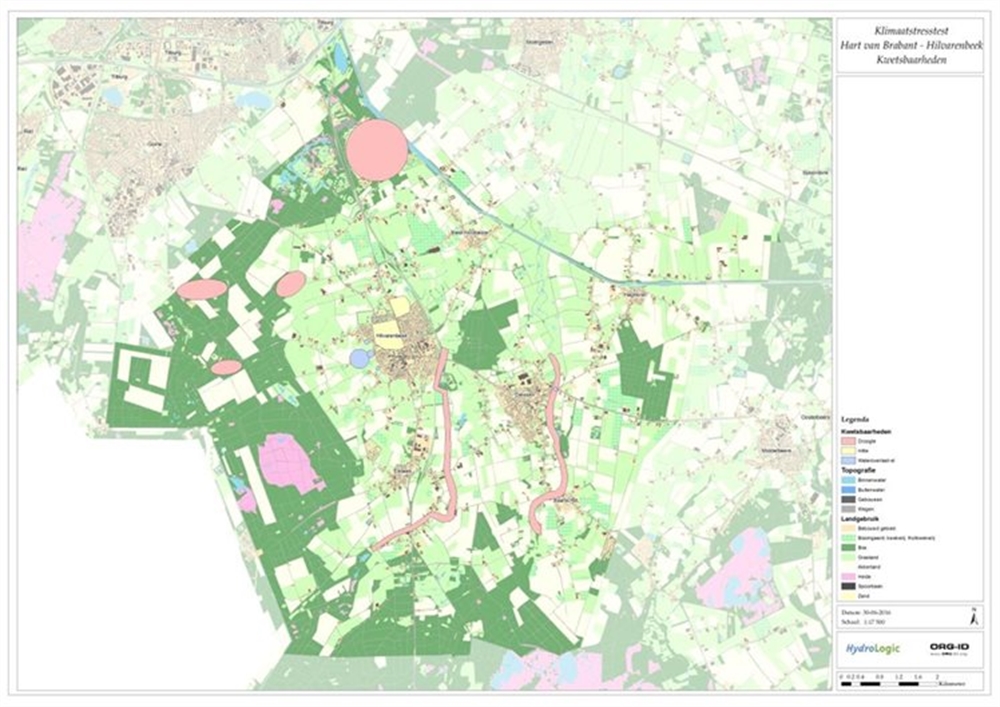Hilvarenbeek climate workshop
The climate workshop is intended to gain insight into the effects of climate change on the living environment in the municipality of Hilvarenbeek, and the interconnectivity of the various climate issues, the water system, and spatial planning. The workshop involves a “stress test light”: insight into the tasking with which the parties are faced, and recommendations regarding subsequent steps, based on knowledge and information currently available. In essence, the climate workshops focus on the four themes set out in the climate impact atlas: flood risk management, pluvial flooding, drought, and heat. Flood risk management is not an issue for the municipality of Hilvarenbeek, which is why it has been left out of consideration.
Process
The climate workshop was structured as follows:
- During an intake meeting, the participants have exchanged their views regarding the purpose and scope of the workshop. In addition, they have drawn up a draft schedule and a list of individuals and organisations to be invited. They have also set down agreements regarding the exchange of information.
- The actual climate workshop was held on 3 June 2016.
- The workshop was evaluated on 5 July.
In preparation for the climate workshop, basic maps have been drafted for the three relevant climate issues, indicating the climate effects to be expected (see Appendix B to the downloadable document). These maps have been discussed during the workshop. The information contained in the maps has been assessed for completeness and relevance to the municipality. The discussions on the basic maps have been summarised into a vulnerabilities map, indicating the locations at which the municipality of Hilvarenbeek is vulnerable to climate change, and the issues that may come into play.
Results
The climate workshop has generated the vulnerabilities map below.

During the climate workshop, we discussed the climate issues. The main comments and vulnerabilities are:
Knowledge issues and development
- To what extent is the location at which the arterial waterways leave the urban area prone to flooding? Should this water storage area be expanded?
- How will drought impact precipitation-fed and seepage-fed pools? Which pools are precipitation-fed, and which ones are seepage-fed?
- Have climate effects been taken into account in the design of “wet pearls of Nature”?
Climate impact
Flooding
- The municipality uses arterial waterways to discharge rainwater beyond the urban area. The location into which these waterways discharge may potentially be prone to flooding. This requires further study.
- Several locations in the urban area have been marked with groundwater or pluvial flooding. A number of these flooding issues have already been resolved.
- A large number of areas marked with flooding from brooks following a T100 downpour involve wet Nature. The other major location, between Biest-Houtakker and Haghorst, that is prone to flooding during a T100 downpour involves a designated water storage area.
- Some locations are affected by slight groundwater flooding. The majority are located along watercourses.
Drought
- Lake Victoria, east of “Beekse Bergen” Safari Park, is a large seepage-fed pool. It currently serves as a swimming pool. It is already connected to the canal: water from the pool can flow to the canal, but not vice versa. Future drought may reduce the volume of seepage. In the future, the connection between the pool and the canal could perhaps be adjusted, in order to enable the canal to feed the pool.
- A fall in groundwater level may contribute to the death of a number of tree species, such as oak trees.
Heat
- The city centre already comprises a great deal of greenery, but the “urban heat island” effect is still marked intense on the map.
- There is an optimum to the number of trees. If there are too many, individual trees will have insufficient room to grow. A limited number of appropriate trees is preferable to a large number of inappropriate trees.
More details on the conclusions and recommendations are provided in the document pertaining to this practical example.
Contact person
Albert Elshof
ORG-ID
06 53 66 18 69
elshof@org-id.org
